Thank you LarryW, Larry and Donald.
Here in zone 4 it is easy to tell - all of the daylilies I grow are dormant. It does not matter whether they were registered as dormant, semi-evergreen or evergreen they will all remain dormant for the entire winter.
I am hoping among the cultivars that you gentlemen have listed I may find a daylily that is dormant, since from the basis of my tests I have been unable to find any daylily that is dormant.
Although this will be a long post perhaps by its end I will have successfully explained that contradiction above and begun to provide some preliminary information about how daylilies grow.
Lets look at the registration information for foliage from
http://www.daylilies.org/AHSre...
"FOLIAGE HABIT
Circle the abbreviation which best applies to your cultivar. Daylilies have three types of growth.
Evergreen (ev.) These daylilies retain their foliage throughout the year. In the north, these plants over winter as a mound of frozen pale green foliage. Evergreens may resume growth during a mid-winter thaw in mild climates.
Semi-evergreen (sev.) The foliage of these daylilies dies back nearly to the ground in very cold climates. Some green will be seen near the base. Generally, semi-evergreens wait until spring to resume growth.
Dormant (dor.) These daylilies lose their foliage completely before or shortly after frost and over winter with pointed foliage buds, usually just beneath the soil surface. Dormants will resume growth in spring. "
Unfortunately these definitions mix two different plant characteristics. One of these is growth. Dormant means more or less not growing. The other is how long leaves live or whether leaves are present or absent in winter. Evergreen means more or less that some green living leaves are present in winter. If you look at what your daylilies actually do in your garden then trying to fit their behaviour into these categories will often be like trying to fit a square peg into a round hole. They do not fit.
A daylily is dormant when a special part of it, the growing point or apical meristem (shoot apical meristem or SAM) on the crown is not visibly growing. The job of that part is to produce new baby leaves. After a baby leaf is produced its growth (getting longer and wider) is the leaf's job not the job of the SAM. We cannot properly tell if a daylily fan is growing by looking at it only one time. Just as we can only tell if our children are growing by measuring them at two separate times and checking to see if there is a difference we must observe the daylilies on at least two separate occasions to know whether they are dormant or not.
To know whether a daylily fan is dormant we have to look for new baby leaves. They can be seen in the centre of the fan. A new leaf will appear in the centre of the fan every few days when the fan is growing. How long it takes before a new leaf appears will depend on the temperature. When it is warm new baby leaves will appear more quickly than when it is cold. In the figure below we can assume that the shorter leaves have been appearing, one every few days and that the fan is not dormant.

The longer leaves are adult or mature leaves.
In the next figure there are no short baby leaves - none have been produced for some time. All the leaves are now adult and mature and the fan is dormant.
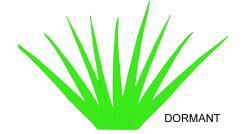
A daylily can be dormant whether it has green leaves or not. One cannot tell if a daylily is dormant by looking at it only one time. If new baby leaves appear in the centre of a daylily it is not dormant and if they do not appear then it is dormant.
Leaves live for a certain amount of time - they have a lifespan. We can expect that in cool conditions, when temperatures are low but the plant can still grow its leaves will probably be able to live longer than when the temperatures are warmer. If it gets too cold or too hot green leaves will start to age or senesce. They start to turn yellow, start to dry and finally turn greyish-brown and die. Since the leaves were produced one at a time separated by some number of days then they may die one at a time separated by some number of days. Or sometimes there may be a sudden extreme event (for example a very cold or very hot temperature) and all the leaves start to die at the same time. When the leaves start to yellow and die can be completely unrelated to when the growing point went dormant.
Lets look in more detail at the daylily in the second figure which has green leaves but is dormant.
Those leaves could stay green for several months and no new leaves might be produced during that time. All that time the daylily would be dormant. After the two months the leaves might have reached old age and each might slowly begin to die. When enough of the leaves have died the growing point might break dormancy and start to produce new baby leaves again. The fan would no longer be dormant. It might have a few old mature green leaves from the first round of growth and to begin with, a few new baby (short) leaves from the second round of growth.
OR
The fan might stay dormant until all the old leaves have died. In that case it might disappear completely underground. Whether it does or not would depend on whether it has large buds that peek a little above the soil level or small buds that remain hidden below the soil line. The plant might remain dormant until cold weather arrives or it might break its dormancy and start to produce new baby leaves before the weather becomes too cold to grow.
What about the plant that never goes dormant. It is always producing new baby leaves. Therefore it always has some green leaves. It is evergreen but more precisely it is evergrowing. The new leaves might be produced more slowly when the growing conditions are not the best and they might be produced more quickly when the growing conditions are good. The speed at which the new leaves are produced will vary. If the plant experiences an extreme event, for example the temperature goes well below freezing or very high then all the leaves it has, will start to die but it still will produce new baby leaves to replace the dying leaves (unless the growing point was killed by the extreme event).
When temperatures are too low plants do not grow. By definition they are dormant. That kind of dormancy is caused by conditions that are outside of the plant - in the environment. That type of dormancy is called ecodormancy.
All daylilies can become ecodormant. For example, they can all stop growing (producing new baby leaves) when it is too cold, or too hot or too dry.
In winter, all the daylilies in my garden are ecodormant. The temperatures are too low for them to grow and the daylilies will not be able to grow again until spring, possibly late March or early April when the temperatures have become sufficiently above freezing. If a daylily is only ecodormant then if I dig it up and bring it inside and provide it with good growing conditions, especially warmth, it will start to grow without much delay. Lets look back at the registration definition for dormancy, and we ignore the loss of leaves part (because it is not a requirement for plant dormancy) but focus on the requirement for pointed buds and no growth until spring. According to that part of the definition, in locations where there are warm spells during winter a dormant daylily should not start to grow. My interpretation is that ecodormancy is not the type of dormancy required for a daylily to be registered as a dormant.
There is a second type of dormancy. This type of dormancy does not depend on the external growing conditions. Even if those are conducive to growth in these cases a dormant daylily will not grow until it is ready to grow. This type of dormancy is called endodormancy because it depends on conditions within the growing point. If a daylily is endodormant during the winter and I bring it inside and give it good growing conditions it will not start to grow relatively quickly; it may never start to grow at all; it may not grow for a long time or it may take a lengthy time to start to grow and then not grow normally - it may or may not then die. In locations where there are warm winter spells an endodormant daylily will not start to grow again until spring.
So far, every daylily that has gone dormant in my conditions and that I have brought inside to test has started to grow quickly. None of the tested daylilies are endodormant - they all have been ecodormant. Stout did the same test. He took a number of daylilies inside into a greenhouse in November in New York city. They all started to grow quickly. None were endodormant; all were ecodormant. I have tried bringing daylilies inside in mid-October - they were only ecodormant. This next year I will try bringing them inside in September or earlier. Stout thought that a few specific species-type daylilies might have become endodormant while growing in the greenhouse during winter. The reason he thought this, was because they became dormant after growing in the greenhouse for some time and then sometime later when they started to grow again they did not grow normally. Some endodormant plant species need to experience sufficient cold (chilling hours or days) to properly break their dormancy. When Stout chilled the abnormally growing daylilies for 30 days they then grew normally.
In my tests I have found no daylily that grew abnormally after I brought them inside. I have found no daylily that required chilling to grow properly. I am now testing the same daylily species (I hope) that Stout found required chilling to grow normally after going dormant inside. But even if that daylily species does require chilling so far it seems that endodormancy may have been bred out of all modern daylily cultivars.
In Dan Hansen's videos about dormancy he talks about dormancy in 'Taos'. From the AHS registration database:
Taos (Stamile, 1999) height 24in (61cm), bloom 6in (15.0cm), season EM, Rebloom, Dormant, Tetraploid, Fragrant, 26 buds, 3 branches, Pastel cream pink blend with gold edge above green throat. (((Ming Porcelain × Crush on You) × sdlg) × Shimmering Elegance)
'Taos' is registered as a dormant. I am growing a row of 'Taos' for testing. My notes indicate that as of Sept. 17 of last year the 'Taos' plants were dormant but still had some green leaves. Beside them other daylily cultivars were not dormant. I dug up three fans of 'Taos' on Dec 27 of last year. At that time all the leaves were dead and the plants were completely underground. The next three photographs show the three buds after I cleaned off the soil on Dec 27.
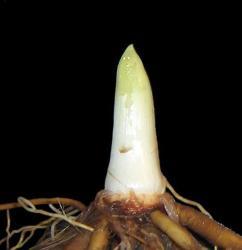
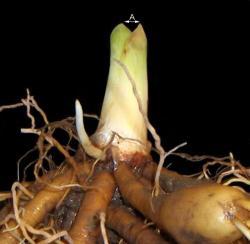
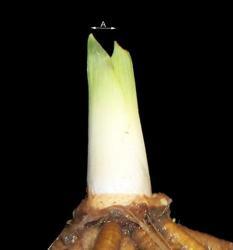
All three buds had been completely underground. Only one bud had a pointed tip. Because two of the buds showed an M-shaped tip (the separation labelled A) I guessed that all three buds were only ecodormant, that they had already started to grow in the autumn and then the temperatures became too low and they stopped growing and that all three were only ecodormant. In fact all three started to grow within two days of being brought inside. (the three buds are in the same order below as they are above). They have continued to grow.


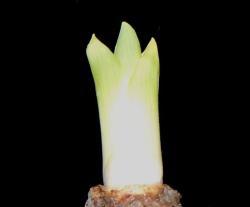
'Hyperion' goes dormant in Florida (Gainesville); goes completely underground and does not reappear until spring (March?). I tested it here. It starts to grow quickly when brought inside - it is ecodormant not endodormant.
Perhaps I will find an endodormant cultivar among those listed above. (typing errors will be corrected later and I may add more information, please bear with me.)







